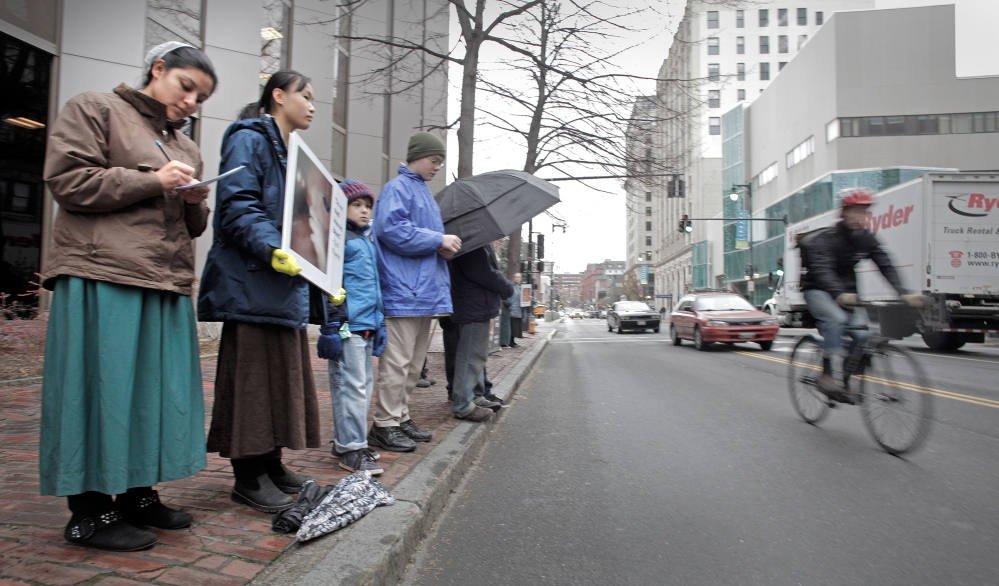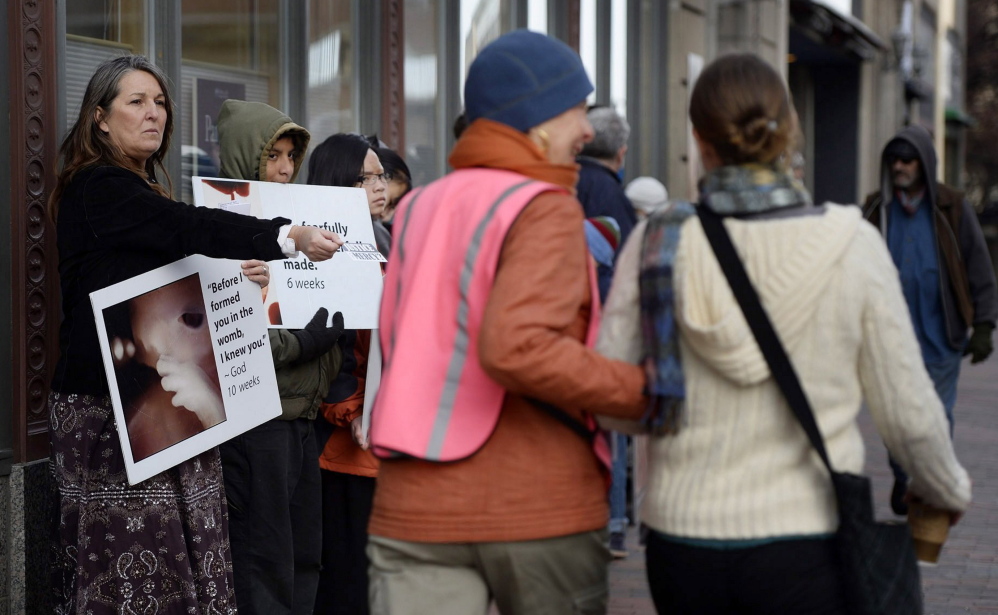Attorneys for anti-abortion activists who are suing to overturn Portland’s ban on protests in a buffer zone around an abortion clinic were encouraged Thursday by the U.S. Supreme Court’s unanimous decision to strike down a similar law in Massachusetts.
In the 9-0 decision, the nation’s highest court ruled that Massachusetts’ law banning protesters from 35-foot zones around the entrances to abortion clinics is an unconstitutional infringement on the demonstrators’ free-speech rights.
The issue pits opponents of abortion, who say they have a right to protest and counsel women not to get abortions, against advocates for women’s choice, who say the buffer zones are a necessary response to violence against abortion clinics and their workers.
“Today’s ruling recognized the vital importance of our free-speech rights,” wrote Erin Mersino, an attorney at the Thomas More Law Center in Michigan who is representing three Maine protesters in an appeal in U.S. District Court in Portland.
“The Supreme Court’s decision should have a substantial impact on the pending case,” Mersino wrote. “The city of Portland’s ordinance is even more restrictive than the Massachusetts law ruled unconstitutional by the Supreme Court. Therefore, we are hopeful that the (District Court) will also strike down the city of Portland’s ordinance on the same basis.”
Jessica Grondin, Portland’s spokeswoman, emailed a brief response to the ruling, saying, “We need to conduct a review of the Supreme Court’s ruling to examine how it will apply to our buffer zone ordinance here in Portland. In regards to our pending legal case, we will wait to hear from the court to see what the next steps are.”
Mersino and her clients are asking the court in Portland to suspend the 39-foot buffer zone around the Planned Parenthood clinic on Congress Street. The Portland City Council passed the ordinance in November.
Daniel and Marguerite Fitzgerald of Shapleigh and their children sued the city, Mayor Michael Brennan and each member of the City Council after the ordinance was enacted, claiming that the buffer zone violates the First and Fourth amendments to the U.S. Constitution, which protect free speech and prohibit unlawful search and seizure.
They were joined in the case in March by another anti-abortion protester, Leslie Sneddon of Richmond.
Judge Nancy Torresen is considering the protesters’ motion to suspend the ordinance while their federal case against the city is pending.
During oral arguments on that motion last week, Torresen called the U.S. Supreme Court’s pending ruling in the Massachusetts case the “elephant in the room.”
Mersino said she planned to make an additional filing in the Portland case to cite the Supreme Court’s decision.
A ‘DISREGARD’ FOR PATIENT SAFETY
Nicole Clegg, spokeswoman for Planned Parenthood’s Portland office, said the organization is “disappointed by the Supreme Court’s decision” and that striking down the buffer zone law in Massachusetts “shows a disregard for the safety of patients and staff entering reproductive health centers.”
“We are taking a close look at today’s ruling and examining how it impacts Portland’s buffer zone,” Clegg said in a written statement. “Regardless of today’s decision, we remain committed to protecting the privacy and safety of our patients and will work to ensure that women are able to make their own health care decisions without fear of harassment or intimidation.”
Planned Parenthood clinics provide health exams for women, cancer screenings, tests for sexually transmitted diseases, birth control and abortions.
An attorney for the plaintiffs in Maine argued in the hearing last week that despite the similarities between the Massachusetts and Portland cases, there are key differences. In Massachusetts, police were unable to control large crowds outside abortion clinics where violent crimes occurred. In Portland, the protests have not been violent.
The city’s attorney, Patricia McAllister, argued that the City Council specifically passed the buffer zone because the Planned Parenthood clinic is in the center of the downtown, accessible only by public sidewalks, and police lack the resources to stand guard outside.
“The lack of criminal behavior here does not mean that patients are not intimidated and frightened,” McAllister told the judge. “The entire impetus of the City Council’s action in this case was to give the people the option of entering the building without running the gauntlet.”
For about a year before Portland’s ordinance was enacted, 10 to 25 protesters, including children, gathered regularly in front of Planned Parenthood’s entrance, some holding large signs with graphic photos of aborted fetuses. Some shouted Bible verses at women and called them murderers.
Soon after the protests started, Planned Parenthood hired police officers to ensure that the protests did not get out of control. The clinic had volunteers in brightly colored vests help patients navigate the crowd.
McAllister said protests of all sorts occur almost every day in Monument Square, across Congress Street from the clinic, and the anti-abortion protesters can spread their message from there, including holding signs and praying.
COURT CITES FIRST AMENDMENT
The Massachusetts case began when abortion opponents such as Eleanor McCullen, a grandmother from the Boston area, sued over the limits on their activities at Planned Parenthood clinics in Boston, Springfield and Worcester.
In Springfield and Worcester, the protesters said they had little chance of reaching patients who arrived by car because they were required to stay 35 feet from the entrance to the buildings’ parking lots.
Rather than chant anti-abortion slogans, preach loudly or wave signs, McCullen said she engages in “sidewalk counseling,” in which she and others try to have brief, personal conversations with women they believe are seeking abortions, present alternatives to them and distribute literature that explains options, according to The Associated Press.
Such personal, one-on-one communication has historically been an effective way to move people to action or communicate effectively, the court wrote in its ruling.
“But while the First Amendment does not guarantee a speaker the right to any particular form of expression, some forms – such as normal conversation and leafletting on a public sidewalk – have historically been more closely associated with the transmission of ideas than others,” the court wrote.
While the state of Massachusetts noted in its defense that its law does not prevent forms of protest such as chanting slogans or showing signs, “that misses the point,” the court wrote.
“They seek not merely to express their opposition to abortion, but to inform women of various alternatives and to provide help pursuing them. … It is thus no answer to say that petitioners can still be ‘seen and heard’ by women within the buffer zones. If all that women can see and hear are vociferous opponents of abortion, then the buffer zones have effectively stifled the petitioner’s message.”
Massachusetts’ legislature passed the law in 2007 to update a “floating buffer” rule that was meant to prevent protesters from getting any closer than 6 feet from unwilling listeners if they were within 18 feet of a clinic.
Planned Parenthood said protesters could still stand next to the entrances and force patients to squeeze past them to enter.
The floating zone was modeled after a Colorado law that the U.S. Supreme Court upheld. That decision was not called into question in Thursday’s ruling.
Clinic officials said they were most concerned about safety because of past incidents of violence. In 1994, a gunman killed two receptionists and wounded five employees and volunteers at a Planned Parenthood facility and another abortion clinic in Brookline, Massachusetts.
Staff Writer Scott Dolan contributed to this report.
Matt Byrne can be contacted at 791-6303 or at:
Twitter: MattByrnePPH
Send questions/comments to the editors.




Success. Please wait for the page to reload. If the page does not reload within 5 seconds, please refresh the page.
Enter your email and password to access comments.
Hi, to comment on stories you must . This profile is in addition to your subscription and website login.
Already have a commenting profile? .
Invalid username/password.
Please check your email to confirm and complete your registration.
Only subscribers are eligible to post comments. Please subscribe or login first for digital access. Here’s why.
Use the form below to reset your password. When you've submitted your account email, we will send an email with a reset code.